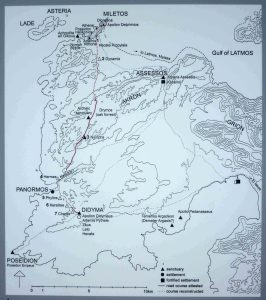LAST Sunday saw the annual Sacred Way walk from Akkoy to Apollo Temple. Voices columnist Glenn Maffia takes you for a ramble down its historical byways
ARCHAEOLOGY, since Charles Newton (1857/8) until this day, has continued to reveal important and fascinating evidence of the practices of religious observation duly performed in honouring the god Apollo at Didyma.
One of the most intriguing being the procession from the Apollo Delphinion in Miletus along the Sacred Way to Apollo’s sanctuary at Didyma.
The Molpoi
There once existed a prestigious Milesian cult association instrumental in the rituals surrounding the pagan deity of Apollo, named the ‘Molpoi’ (Singers). The god’s many accoutrements included that of music after all.
An inscription dated from c.100 BCE records a cult law from this society, upon which is included a tract from 479/478 BCE (just after the defeat of the Persians at the Battle of Mykale).
It informs us of the procession from Miletus along the route of the Sacred Way, specifying the precise ceremonies and venues which were performed upon the way.
Naturally, there were rites that would have been performed once they arrived at Didyma, though these are not recounted upon this piece of evidence, with exception of laying a ‘gyllos’ (a basket of donations or dedications) at the ruined doors of the archaic temple.
The Archaic Temple was destroyed by the Persians in 494 BCE, though the cult remained active throughout the period before the construction of the Hellenistic temple began.
Mapping the route
This cult decree from the Molpoi plots their route across the undulating hills, valleys and meadows with such precision it has been possible to locate many of their locations for sacrificial offerings and hymn singing.
From the south gate of Miletus (the only leading landward in ancient times) the procession led over initial flat land before rising over the barrier of hills running from west to east along the Milesian peninsula.
 The German archaeologist Karl Wiegand postulates the route passed through a wood (drymos) and upwards, it was just before the pinnacle of the “height” (akron) that the procession paused in a meadow (lemon) to sing their hymns to the nymphs.
The German archaeologist Karl Wiegand postulates the route passed through a wood (drymos) and upwards, it was just before the pinnacle of the “height” (akron) that the procession paused in a meadow (lemon) to sing their hymns to the nymphs.
From there the road went over the brow of the hill and into a ravine called Dyo Bryseis (Two Springs) descending from the “height”, around another hill before reaching the sea just north of Panormos (modern day Mavisehir), three and a half kilometres north-west of Didyma.
Thereafter they made stops at three unidentified places before arriving at the Chares group of statues (now in the British Museum), which lined the Sacred Way before the temenos (sacred enclosure) limits of Didyma. Finally they arrived at the entrance to the enclosure of the Temple of Apollo.
The trek concludes
The boundary of the Didymaean temenos was around 300 metres from the Temple itself, a huge area which afforded sanctuary (sanctified, as in purified).
Another Molpoi inscription alludes to gates (thyrai) at Didyma in the fifth century BCE, though this may well be a reference to the entrance of the Apollon precinct or even the Temple doors themselves.
Nonetheless, in c.100/101 CE when the Emperor Trajan was repairing the Sacred Way, a gate, perhaps in the form of an arch, was built. In 1907 the foundations of this structure were discovered.
A perplexing anomaly continues to exist upon the route of the Sacred Way. From the temenos the road progresses nearly 200 metres before turning in a dog-leg east direction some 150 metres north of the north-west corner of the Temple.
It was always thought that this turn would naturally follow to the main façade of the temple.
Two archaeological digs in 2014 and 2015 revealed nothing. The proposal was they had been “robbed out”; the stone used for later constructions. Plausible, and understandable, within the intervening centuries, though still a perplexing riddle.